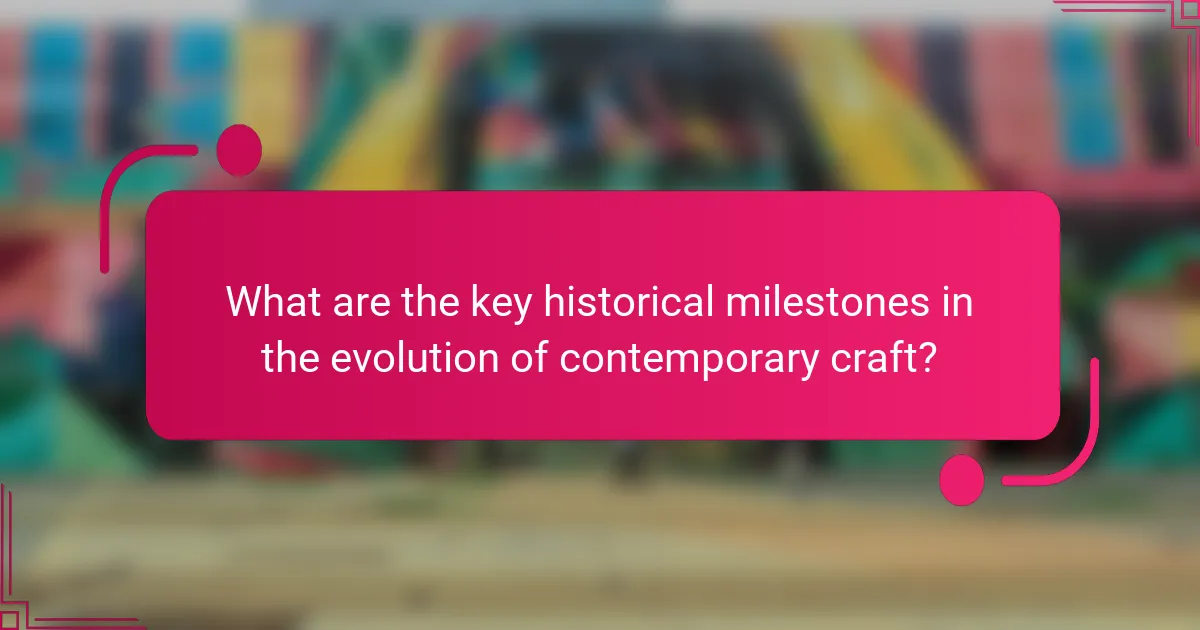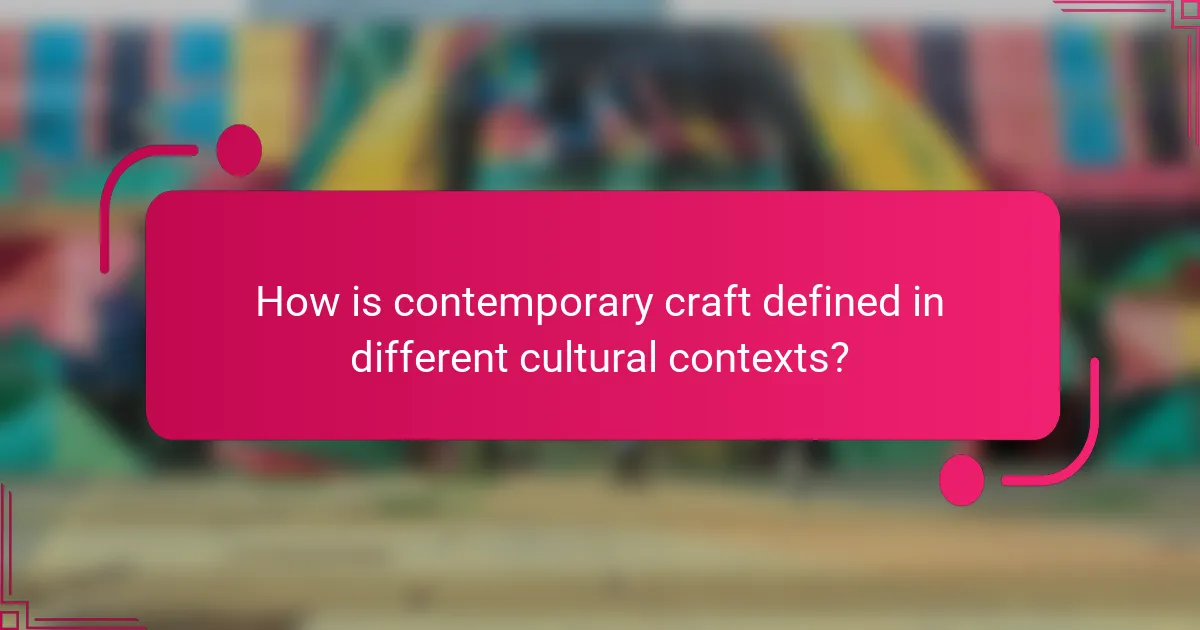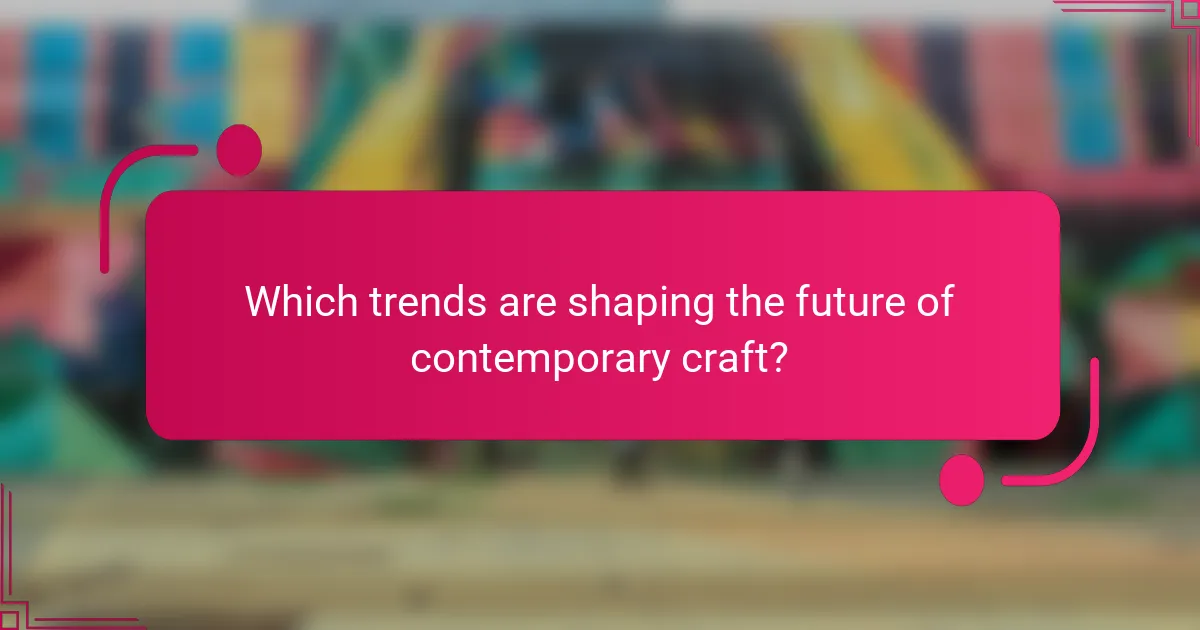The evolution of contemporary craft reveals significant historical milestones that shape its current landscape. Key movements include the Arts and Crafts Movement, studio craft, and postmodernism, each influencing artistic expression. Contemporary craft integrates traditional techniques with modern values, focusing on sustainability and technology. Future directions emphasize community engagement and innovative practices, addressing both market challenges and emerging trends.

What are the key historical milestones in the evolution of contemporary craft?
The evolution of contemporary craft has seen several key historical milestones. The Arts and Crafts Movement in the late 19th century emphasized handmade quality and traditional techniques. The mid-20th century introduced studio craft, focusing on individual artists and unique creations. The rise of postmodernism in the 1980s challenged traditional definitions, incorporating mixed media and conceptual art. Recent trends highlight sustainability and technology, reflecting contemporary values and practices. Each milestone has shaped the craft landscape, influencing current and future directions.
How did the Arts and Crafts Movement influence modern practices?
The Arts and Crafts Movement significantly shaped modern practices by emphasizing craftsmanship and the value of handmade goods. This movement reacted against industrialization, promoting a return to traditional skills and materials.
Its influence is evident in contemporary design, where sustainability and artisanal techniques are prioritized. The movement’s focus on aesthetics and functionality continues to inspire modern artisans and designers, fostering a culture that values quality over mass production.
As a result, today’s craft practices often incorporate eco-friendly materials and methods, reflecting the movement’s enduring legacy in promoting a thoughtful approach to creation. This shift towards sustainability is a unique attribute that distinguishes contemporary craft from its industrial predecessors.
What role did the Bauhaus play in shaping contemporary craft?
The Bauhaus significantly influenced contemporary craft by integrating art, design, and technology. Its emphasis on functionality and simplicity reshaped the approach to materials and techniques used in craftsmanship. The school promoted a collaborative atmosphere, encouraging artisans and designers to work together, which led to innovative practices still relevant today. Bauhaus principles, such as the unity of form and function, continue to inspire contemporary artisans in their pursuit of aesthetic and practical design. This legacy fosters a blend of traditional craftsmanship with modern technology, driving the evolution of craft into the future.
Which cultural shifts have impacted craft trends in the 20th and 21st centuries?
Cultural shifts such as the rise of sustainability, digital technology, and globalization have significantly influenced craft trends. The environmental movement has encouraged eco-friendly materials and practices. Digital tools have expanded creative possibilities and access to global markets. Globalization has led to cross-cultural exchanges, enriching craft traditions.

How is contemporary craft defined in different cultural contexts?
Contemporary craft is defined by its adaptability to cultural contexts, integrating traditional techniques with modern expressions. In various cultures, it reflects local materials, social issues, and artistic movements. For example, in Japan, contemporary craft emphasizes minimalism and harmony, while in Africa, it often focuses on community and storytelling. This evolution showcases a blend of heritage and innovation, highlighting the unique attributes of each cultural perspective. The future of contemporary craft lies in its potential to foster global dialogues while preserving local identities.
What are the distinguishing characteristics of North American contemporary craft?
North American contemporary craft is distinguished by its emphasis on individual expression, diverse materials, and cultural narratives. This craft movement reflects a blend of traditional techniques with innovative practices, showcasing unique attributes like sustainability and community engagement. The evolution of this craft has led to a rich tapestry of artistic voices, often addressing social issues and personal stories through various mediums. As a result, contemporary craft continues to redefine boundaries and explore new directions in artistry.
How does contemporary craft manifest in European traditions?
Contemporary craft in European traditions reflects a blend of historical techniques and modern innovation. This evolution showcases a commitment to preserving heritage while embracing new materials and technologies. The integration of traditional craftsmanship with contemporary design principles creates unique, functional art. For instance, artisans often use sustainable practices to address current environmental concerns. This fusion allows contemporary craft to resonate with both cultural identity and modern aesthetics.
What unique aspects define contemporary craft in Latin America?
Contemporary craft in Latin America is defined by a blend of traditional techniques, innovative materials, and cultural narratives. Artisans emphasize sustainability and community engagement, reflecting local heritage while adapting to global trends. Unique aspects include the incorporation of indigenous practices and the fusion of modern art with craftsmanship, creating a distinctive identity. This evolution showcases a commitment to preserving cultural significance while exploring new artistic expressions.

What are the core materials and techniques used in contemporary craft?
Contemporary craft utilizes a variety of materials and techniques that reflect its evolving nature. Key materials include natural fibers, metals, ceramics, and reclaimed objects, each offering unique aesthetic and functional qualities. Techniques such as weaving, pottery, metalworking, and mixed media are prevalent, showcasing innovation and traditional craftsmanship. The integration of technology, like digital fabrication, is a unique attribute that distinguishes contemporary practices from historical methods. This blend of materials and techniques not only enhances creativity but also addresses sustainability in craft.
Which sustainable practices are emerging in contemporary crafting?
Emerging sustainable practices in contemporary crafting include upcycling, eco-friendly materials, and local sourcing. Craftspeople are increasingly adopting these methods to reduce waste and minimize environmental impact. Upcycling transforms discarded items into new products, while eco-friendly materials prioritize renewable resources. Local sourcing supports community economies and reduces carbon footprints. These practices reflect a growing awareness of sustainability within the crafting community.
How do digital technologies influence contemporary craft techniques?
Digital technologies significantly enhance contemporary craft techniques by introducing innovative tools and methods. These advancements enable artisans to experiment with materials and processes, leading to unique creations. For instance, 3D printing allows for intricate designs that were previously impossible. Additionally, digital platforms facilitate global collaboration and exposure for crafters, expanding their reach and influence. As a result, the fusion of traditional craftsmanship with digital innovation shapes the future of the craft industry, making it more dynamic and accessible.

What are the social and community impacts of contemporary craft?
Contemporary craft significantly impacts social and community dynamics by fostering connections and promoting cultural exchange. It encourages collaboration among artisans, enhancing local economies through small businesses. Craft initiatives often address social issues, providing platforms for marginalized voices and promoting inclusivity. Additionally, contemporary craft fosters environmental awareness through sustainable practices, influencing community values toward eco-consciousness. These elements collectively strengthen social bonds and enrich community identity.
How does contemporary craft foster community engagement and collaboration?
Contemporary craft fosters community engagement and collaboration by creating shared spaces for creativity and dialogue. These environments encourage interaction among diverse groups, enhancing social cohesion. Workshops and events allow participants to learn skills and share experiences, forging connections. Collaborative projects often highlight local culture, further uniting communities. This evolution emphasizes inclusivity, accessibility, and sustainability, shaping the future of craft as a communal practice.
What role does craft play in cultural identity and expression?
Craft plays a vital role in cultural identity and expression by reflecting traditions, values, and community narratives. It serves as a medium for individuals to connect with their heritage and express personal stories. Contemporary craft evolves by incorporating modern techniques and materials, enhancing its relevance in today’s society. This evolution fosters cultural dialogue and innovation, ensuring craft remains a dynamic form of expression. The unique attributes of contemporary craft, such as sustainability and inclusivity, further enrich cultural identities, making them more diverse and accessible.

Which trends are shaping the future of contemporary craft?
Several trends are shaping the future of contemporary craft, including sustainability, technology integration, and community engagement. Sustainability drives artisans to use eco-friendly materials and practices, reflecting a growing consumer preference for responsible production. Technology integration enhances craftsmanship through digital tools, enabling innovative designs and broader reach. Community engagement fosters collaboration among artisans, promoting cultural exchange and shared knowledge. These trends indicate a dynamic evolution in contemporary craft, emphasizing both tradition and modernity.
How is the intersection of craft and technology evolving?
The intersection of craft and technology is evolving through innovative techniques and digital tools. Contemporary artisans increasingly incorporate advanced technology, such as 3D printing and CNC machining, into traditional craft practices. This fusion enhances creativity, allowing for intricate designs and efficient production methods. Additionally, technology enables broader accessibility, connecting artisans with global markets and audiences. As a result, the future of craft is characterized by a dynamic blend of heritage and modernity, fostering new artistic expressions and sustainable practices.
What are the emerging markets and audiences for contemporary craft?
Emerging markets and audiences for contemporary craft include younger generations, global artisans, and eco-conscious consumers. These groups seek unique, sustainable products that reflect personal values and cultural narratives.
Younger audiences prioritize handmade goods, often discovered through social media platforms. Global artisans leverage digital marketplaces to reach wider audiences, showcasing diverse cultural expressions. Eco-conscious consumers demand sustainable materials and ethical production methods, driving innovation in contemporary craft.
As a result, the contemporary craft landscape is evolving to meet these new demands, fostering inclusivity and sustainability.

What are the challenges facing contemporary craft practitioners today?
Contemporary craft practitioners face several challenges, including market saturation, sustainability concerns, and the impact of digital technology. Market saturation limits visibility for individual artisans, making it difficult to stand out. Sustainability demands require crafters to source materials responsibly, which can increase costs. Additionally, digital technology changes how crafts are marketed and sold, posing both opportunities and challenges in adapting to new platforms.
How do economic factors affect the viability of craft businesses?
Economic factors significantly influence the viability of craft businesses by affecting costs, pricing, and consumer demand. Rising material costs can limit production capabilities, while economic downturns often reduce discretionary spending. Craft businesses must adapt to fluctuating market conditions to sustain profitability. For instance, during economic growth, consumers are more likely to invest in handmade goods, enhancing sales opportunities. Conversely, in a recession, these businesses may struggle. Understanding local economic trends is crucial for strategic planning and long-term success.
What are common misconceptions about contemporary craft?
Common misconceptions about contemporary craft include the belief that it is solely about traditional techniques or that it lacks innovation. Many think contemporary craft lacks artistic value, overlooking its blend of functionality and aesthetics. Additionally, some assume it is only for niche markets, while in reality, it has widespread appeal across various demographics. Lastly, there is a misconception that contemporary craft is not influenced by technology, when in fact, many artisans incorporate modern tools and methods to enhance their work.

How can practitioners optimize their craft for future success?
Practitioners can optimize their craft for future success by embracing innovation and continuous learning. They should adopt new technologies and techniques that enhance their skills and efficiency. Networking with peers and engaging in collaborative projects can provide valuable insights and opportunities. Additionally, understanding market trends and consumer preferences will help practitioners align their work with evolving demands. Regularly seeking feedback and adapting to changes will ensure relevance and growth in their craft.
What best practices should contemporary crafters adopt for sustainability?
Contemporary crafters should prioritize sustainable practices by using eco-friendly materials, minimizing waste, and promoting local sourcing. These approaches enhance environmental responsibility and support community economies. Implementing recycling techniques and choosing renewable resources are essential for reducing ecological footprints. Engaging in educational initiatives can further inspire sustainable crafting methods.
Which marketing strategies are effective for contemporary craft businesses?
Contemporary craft businesses benefit from strategies like social media marketing, community engagement, and online marketplaces. These approaches enhance visibility, foster customer connections, and expand sales channels.
Social media platforms allow artisans to showcase their work, engage with audiences, and build brand loyalty. Community events and workshops establish local presence and attract customers. Online marketplaces provide access to a broader audience, essential for growth in today’s digital age.
Adapting to trends like sustainability and personalization can further differentiate brands in the competitive craft market. Emphasizing unique attributes, such as handmade quality and local sourcing, resonates with consumers seeking authenticity.
What common mistakes should contemporary crafters avoid?
Contemporary crafters should avoid common mistakes like neglecting research, underestimating materials, and ignoring market trends. Staying informed helps in creating relevant and appealing work.
1. Skipping historical context can limit creativity.
2. Choosing low-quality materials affects durability and perception.
3. Ignoring target audience leads to mismatched products.
4. Overcomplicating designs can overwhelm potential buyers.
5. Failing to network limits exposure and collaboration opportunities.
